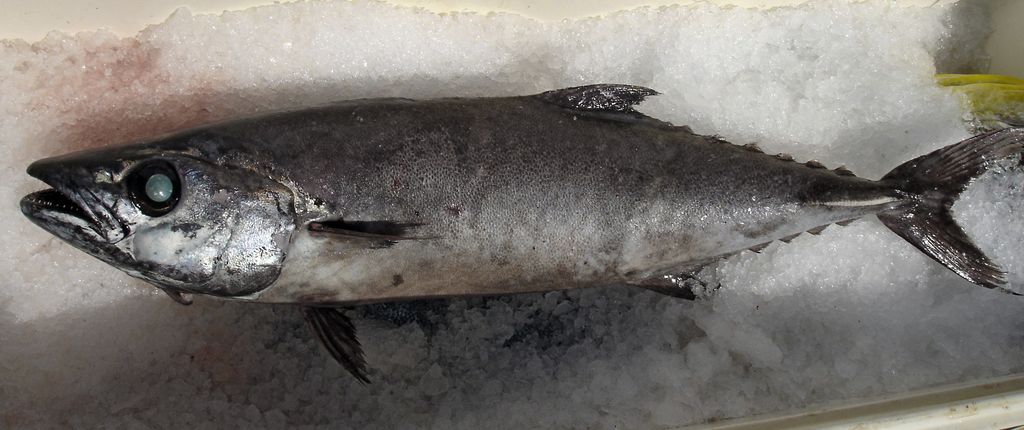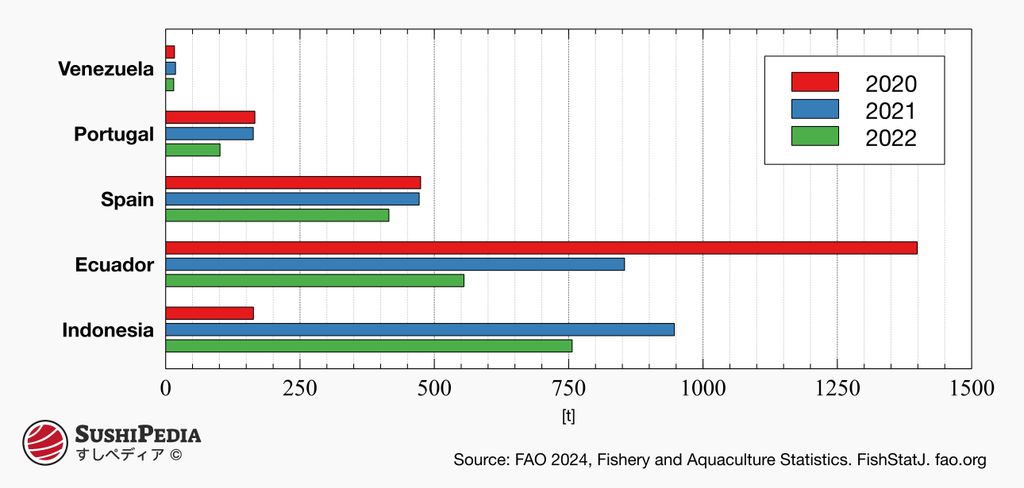Aburasokomutsu Sushi
A Comprehensive Overview of Escolar in Japanese Sushi Cuisine
アブラソコムツすし 、 油底鯥寿司 
What is Aburasokomutsu?
Aburasokomutsu 油底鯥 is the Japanese name for the escolar, which is sometimes referred to “butterfish” or incorrectly “white tuna”. Although occasionally referred to as a butterfish, the Escolar is not a member of the butterfish family, but a member of the snake mackerel family. Unlike in Japan, you can often find aburasokomutsu in the sushi display (neta bako) of western sushi bars and restaurants.

SushiPedia. Escolar Nigiri Sushi. All rights reserved ©
Aburasokomutsu for Sushi or Sashimi
The name “butterfish” or “white tuna” originates from a purely commercial motivation and should sound more appealing to the consumer. However, its full-bodied, very fatty and slightly sweet taste, reminiscent of butter, cannot be denied. There is hardly any other fish that is better suited to the false name “butterfish” or “white toro” than the escolar. The shiny, matte white meat is firm, very tender, full-bodied and accompanied by aromas that have a strikingly strong taste of butter. Compared to tuna, the meat is slightly more sour and less fresh in taste.
When preparing as sushi or sashimi, one should avoid the excessive use of soy sauce or wasabi, a thin glaze is more sufficient. Alternatively, the buttery flavors harmonize very well with a touch of citrus (e.g. yuzu).
As the flesh of the aburasokomutsu contains wax-like lipids, one should refrain from eating larger quantities, as these cause digestive problems (keriorrhea).
Food Fraud
Investigations by the marine protection organization Oceana, showed that escolar was wrongly labeled both in restaurants and at fish markets. The Oceana study concluded that from 2010 to 2013, approximately 84 percent of the 114 tuna samples identified as “white tuna” were actually escolar.[1]
Wrong marking, whether due to ignorance or deception, is a serious problem, especially with the escolar. Aburasokomutsu can cause digestive disorders, especially diarrhea respectively keriorrhea, when consumed due to the wax-like lipids contained in the meat. These lipids are heat-resistant and do not disintegrate when heated. In the absence of specific dose-response studies in the medical literature, doses as low as 95 grams are estimated to be laxative.
The Japanese Ministry of Health, Labor and Welfare 厚生労働省 lists aburasokomutsu as a source of risk for natural poisoning from abnormal lipids and has banned its sale for consumption since 1981.[2]
Aburasokomutsu in Japan
In June 1998, a publicized food poisoning occurred in Tokyo due to the consumption of cooked fish on the lunch menu of a restaurant. Twenty-one out of forty people were poisoned. Their main symptoms were skin irritation, headaches, and palpitations. The subsequent convened official investigation confirmed that the prepared fish responsible for the poisoning was escolar.[3]
Ecology of Aburasokomutsu

Allen Shimada. Lepidocybium flavobrunneum NOAA. U.S. National Oceanic and Atmospheric Administration, NMFS OST. Some rights reserved: Public Domain
The escolar prefers temperate and tropical waters, especially on continental slopes, around the world. They are usually found individually or in pairs, usually at a depth of 200-1100 m (656-3609 ft). Adult specimens can reach a size of over 2 m (6.56 ft) and weigh up to 45 kg (ca. 99 lb). Juveniles in particular, but also larger individuals, migrate vertically to the surface at night to feed on fish, crustaceans and especially squid.
Economy of Aburasokomutsu
The economy of aburasokomutsu, known as Lepidocybium flavobrunneum, is influenced by various factors, including its economic value, ecological impact, and challenges related to identification and management. L. flavobrunneum is occasionally misidentified and mislabeled in the seafood supply chain, undermining consumer confidence and disrupting economic transactions.[4] Additionally, it is sometimes used to adulterate high-value seafood products, leading to economic losses and potential health risks for consumers.[5] Despite its relatively low economic value as bycatch in some fisheries [6], such as the U.S. pelagic longline fishery, understanding its catch per unit effort (CPUE) and biological characteristics is crucial for sustainable management-[6][7]

SushiPedia. Escolar Catch in Metric Tons (2020-2022) - FAO Data. All rights reserved ©
In summary, the economy of Lepidocybium flavobrunneum is small but complex. It is influenced by factors such as mislabeling, illegal fishing, and the economic viability of fisheries. Sustainable management practices based on integrated ecological-economic models and effective measures to combat illegal fishing are crucial to ensuring the long-term economic and ecological sustainability of escolar fisheries.
Season Calendar for Aburasokomutsu
The calendar shown does not provide information on fishing times, but marks the periods in which aburasokomutsu is considered particularly tasty.
Warnings related to Aburasokomutsu
Video about Aburasokomutsu Sushi
External video embedded from: youTube.com. Credit KHON2 News. Beware sushi menus that offer 'white tuna' or 'white maguro'.
Species of Aburasokomutsu
The following species are regarded as authentic aburasokomutsu. Either historically, according to the area of distribution or according to the common practice in today's gastronomy:
Sources and Further Reading
- [1]Kimberly Warner, Walker Timme, Beth Lowell, Michael Hirshfield. Oceana Study Reveals Seafood Fraud Nationwide. Oceana Inc., Washington. 2013
- [2]Ministry of Health, Labour and Welfare (厚生労働省), www.mhlw.go.jp. Risk profile of natural toxins: Fish: abnormal lipids (自然毒のリスクプロファイル:魚類:異常脂質)
- [3]Kimiko Kan, Hirofumi Ushiyama, Tetsuya Shindo, Shinichi Uehara, Kazuo Yasuda. 『アプラソコムツによるヒスタミン食中毒 (Outbreak of Histamine Poisoning Due to Ingestion of Fish, "Abura-sokomutsu". Lepidocybium flavobrunneum)』. Journal of the Food Hygienic Society of Japan (Shokuhin Eiseigaku Zasshi, 食品衛生学雑誌) 42 (2). 2000. DOI: 10.3358/shokueishi.41.116.
- [4]Hwang, Chiu-Chu, Chia-Min Lin, Chun-Yung Huang, Ya-Ling Huang, Fang-Chin Kang, Deng‐Fwu Hwang, Yung‐Hsiang Tsai. Chemical characterisation, biogenic amines contents, and identification of fish species in cod and escolar steaks, and salted escolar roe products. Food Control 25 (1) 415-420. 2012. DOI: 10.1016/j.foodcont.2011.11.008.
- [5]Ye, L. and Xin, H. and Qu, M. and Jiang, Y. and Guo, Y. and Li, F. and Li, N. and Tan, Z. and Wang, L.. Development of duplex real‐time polymerase chain reaction for simultaneous detection of oilfish‑ and escolar‐derived components. Journal of the Science of Food and Agriculture 101 (5) 1792-1799. 2020. DOI: 10.1002/jsfa.10793.
- [6]Juan C. Levesque. Evolving Fisheries: Today’s Bycatch is Tomorrow’s Target Catch - Escolar (Lepidocybium flavobrunneum) Catch in the U.S. Pelagic Longline Fishery. The Open Fish Science Journal 3 (1) 30-41. 2010. DOI: 10.2174/1874401x01003010030.
- [7]Rochman F. , Jatmiko I. , & Wujdi A.. Biology and cpue spatial distribution of escolar lepidocybium flavobrunneum (smith, 1843) in eastern indian ocean (evolving fisheries: today’s by-catch is tomorrow’s target catch). Indonesian Fisheries Research Journal 22 (1) 27. 2016. DOI: 10.15578/ifrj.22.1.2016.27-36.
- [8]Fish and Fishery Products Hazards and Controls Guidance, Fourth Edition – June 2021. U.S. Department of Health and Human Services, Food and Drug Administration Center for Food Safety and Applied Nutrition. 2021
- Christine Dodd, Tim Grant Aldsworth, Richard A. Stein. Foodborne Diseases. Academic Press, Cambridge, Massachusetts, United States. 2017
- Harlan Walker. Fish: Food from the Waters, Proceedings Of The Oxford Symposium On Food And Cookery 1997. Prospect Books, London. 1998
- Jacob H. Lowenstein, George Amato, Sergios Orestis Kolokotronis. The Real maccoyii: Identifying Tuna Sushi with DNA Barcodes – Contrasting Characteristic Attributes and Genetic Distances. PLOS One 4 (11). 2009
- National Oceanic and Atmospheric Administration, National Marine Fisheries Service. Draft Environmental Impact Statement Fishery Management Plan for Pelagic Fisheries of the Western Pacific Region: Environmental Impact Statement, United States.. Research Corporation of the University of Hawaii, URS Corporation, Honolulu. 2000
- P. Berman, E. H. Harley, A. A. Spark. Keriorrhoea – the passage of oil per rectum – after ingestion of marine wax esters. South African Medical Journal 59 (22) 791-792. 1981
- Rainer Froese, Pauly Daniel. FishBase. The Leibniz Institute of Marine Sciences at the University of Kiel, FishBase.org, 2019. Source retrieved 12/24/2020
- Steve Taylor. Advances in Food and Nutrition Research, Academic Press. Academic Press, Cambridge, Massachusetts, United States. 2009
- IUCN Red List of Threatened Species. Version 2023-1
Image Credits
- SushiPedia. Escolar Nigiri Sushi. All rights reserved ©
- SushiPedia. Escolar Catch in Metric Tons (2020-2022) - FAO Data. All rights reserved ©
- SushiPedia. aburasokomutsu. All rights reserved ©
- Allen Shimada. Lepidocybium flavobrunneum NOAA. U.S. National Oceanic and Atmospheric Administration, NMFS OST. Some rights reserved: Public Domain